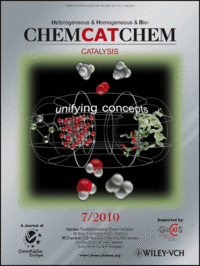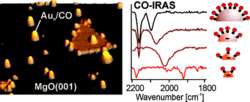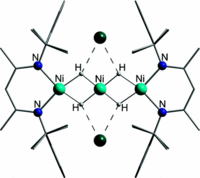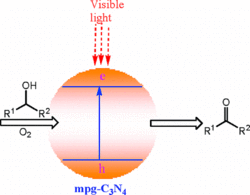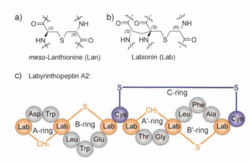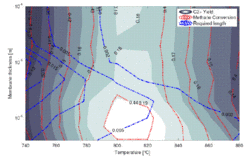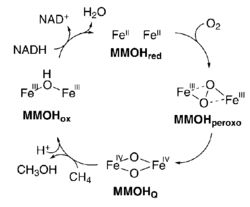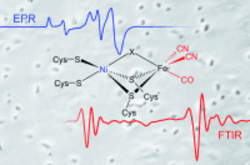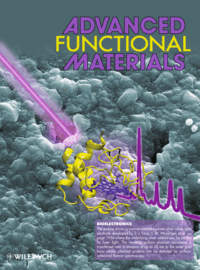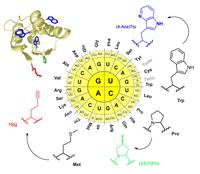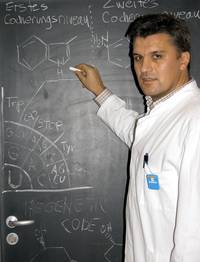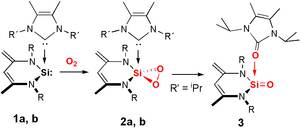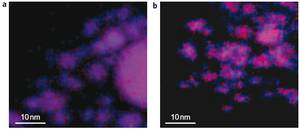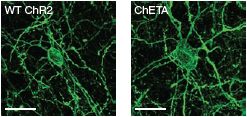Special Issue of ChemCatChem on Unifying Concepts in Catalysis
Christian Limberg and Matthias Driess are guest editors
ChemCatChem 2010, 2, 709 - 875;
After merely two and a half years of UniCat research, it is already visible that the initiative has led to much faster progress through synergisms than would have been possible within the individual branches of catalysis.
Unforeseen exciting new results have been achieved, ranging from materials synthesis for solar-energy-driven catalytic transformations, novel molecular catalysts for facile activation of small molecules, heterogenization of homogeneous catalysts, structuring of surface nanoparticles, structural elucidation of metalloenzyme cofactors, and process modeling to the use of new reactor types.
Charge-Mediated Adsorption Behavior of CO on MgO-Supported Au Clusters
Xiao Lin, Bing Yang, Hadj-Mohamed Benia, Philipp Myrach, Maxim Yulikov, Andreas Aumer, Matthew A. Brown, Martin Sterrer, Oleksander Bondarchuk, Esther Kieseritzky, Jan Rocker, Thomas Risse, Hong-Jun Gao, Niklas Nilius and Hans-Joachim Freund
J. Amer. Chem. Soc. 2010, 132, 7745;
The CO binding behavior to gold particles supported on MgO thin films has been analyzed with scanning tunneling microscopy (STM) and infrared spectroscopy (IRAS). The ad-particles accommodate excess electrons that originate either from a charge transfer through the thin oxide film or from a local interaction with electron-rich oxide defects that act as Au nucleation centers. The enhanced electron density in the Au aggregates affects both the spatial distribution and the vibrational properties of adsorbed CO species.
Whereas preferential CO attachment to the chemically unsaturated and electron-rich boundary sites of the Au islands is deduced from the STM data, a continuous downshift of the CO stretching frequency with decreasing particle size is observed in IRAS. Both results are interpreted in the light of CO adsorption to negatively charged metal aggregates and used to draw general conclusions on the interplay between charge and adsorption properties of confined metal systems.
Homogeneous Stabilization of Pt Nanoparticles in Dendritic Core–Multishell Architectures: Application in Catalytic Hydrogenation Reactions and Recycling
Juliane Keilitz, Michael Schwarze, Sabrina Nowag, Reinhard Schomäcker, and
Rainer Haag
ChemCatChem 2010, 2, 863-870;
Core–multishell architectures are a new approach to homogeneously stabilize metal nanoparticles for harsh conditions. Herein, we present the synthesis and stabilization of Pt nanoparticles in dendritic core–multishell polymers and their application in hydrogenation reactions. The successful recycling of the catalyst was demonstrated for the hydrogenation of methyl crotonate 1 and was either achieved by ultrafiltration or in a two-phase system for at least 14 cycles.
Thereby, the total turnover number (TON) was increased to 22000. In the recycling experiments, low metal leaching into the product (as low as 0.3 ppm) was detected. Additionally, the selective hydrogenation of isophorone 3 was investigated and selectivities of 99:1 for C=C versus C=O hydrogenation were achieved.
A Reduced β-Diketiminato-Ligated Ni3H4 Unit Catalyzing H/D Exchange
Stefan Pfirrmann, Christian Limberg, Christian Herwig, Christina Knispel,
Beatrice Braun, Eckhard Bill, and Reinhard Stösser
J. Am. Chem. Soc. 2010, 132, 13684;
An investigation concerning the stepwise reduction of the β-diketiminato nickel(II) hydride dimer [LNi(μ-H)2NiL], 1 (L ) [HC(CMeNC6H3(iPr)2)2]-), has been carried out. While the reaction with one equivalent of potassium graphite, KC8, led to the mixed valent NiI/NiII complex K[LNi(μ-H)2NiL], 3, treatment of 1 with two equivalents of KC8 surprisingly yielded in the trinuclear complex K2[LNi(μ-H)2Ni(μ-H)2NiL], 4, in good yields.
The Ni3H4 core contains one NiII and two NiI centers, which are antiferromagnetically coupled so that a singlet ground state results. 4 represents the first structurally characterized molecular compound with three nickel atoms bridged by hydride ligands, and it shows a very interesting chemical behavior: Single-electron oxidation yields in the NiII2NiI compound K[LNi(μ-H)2Ni(μ-H)2NiL], 5, and treatment with CO leads to the elimination of H2 with formation of the carbonyl complex K2[LNi(CO)]2, 6.
Beyond that, it could be shown that 4 undergoes H/D exchange with deuterated solvents and the deuteride-compound 4-D4 reacts with H2 to give back 4. The crystal structures of the novel compounds 3-6 have been determined, and their electronic structures have been investigated by EPR and NMR spectroscopy, magnetic measurements, and DFT calculations.
mpg-C3N4-Catalyzed Selective Oxidation of Alcohols Using O2 and Visible Light
Fangzheng Su, Smitha C. Mathew, Grzegorz Lipner, Xianzhi Fu, Markus Antonietti, Siegfried Blechert, and Xinchen Wang
J. Am. Chem. Soc. 2010, 132, 16299;
Mesoporous carbon nitride (mpg-C3N4) polymer can function as a metal-free photocatalyst to activate O2 for the selective oxidation of benzyl alcohols with visible light, avoiding the cost, toxicity, and purification problems associated with corresponding transition-metal systems. By combining the surface basicity and semiconductor functions of mpg-C3N4, the photocatalytic system can realize a high catalytic selectivity to generate benzaldehyde.
The metal-free photocatalytic system also selectively converts other alcohol substrates to their corresponding aldehydes/ketones, demonstrating a potential pathway of accessing traditional mild radical chemistry with nitroxyl radicals.
In Vitro Biosynthesis of the Prepeptide of Type-III Lantibiotic Labyrinthopeptin A2 Including Formation of a C-C Bond as a Post-Translational Modification
Wolfgang M. Müller, Timo Schmiederer, Paul Ensle, and Roderich D. Süssmuth
Angew. Chem. Int. Ed. 2010, 49, 2436;
Lantibiotics are ribosomally synthesized peptide antibiotics containing the amino acids lanthionine (Lan) and methyllanthione (MeLan) as the most important and characteristic post-translational modification.
LabKC is an enzyme encoded in the biosynthesis gene cluster (lab gene cluster) of the labyrinthopeptin producer Actinomadura namibiensis. Some of its genes are homologous with those in other actinomycetes strains, for example, the model organism Streptomyces coelicolor. The functional assignment of LabKC as a kinase–cyclase suggests the formation of a new post-translational modification by a consecutive double Michael addition (see scheme; Dha=α,β-dehydroalanine).
Analysis of attainable reactor performance for the oxidative methane coupling process
S. Jaso, H.R. Godini, H. Arellano-Garcia, M. Omidkhah, G. Wozny
Chem. Eng. Science 2010, 65, 6341;
In this work, acomparative analys is of attainable performance is presented for three different reactor structures including a fixed-bedreactor, and two different feeding structures of packed bed membrane reactors. For this purpose, three types of kinetic models, namely La2O3/CaO, Mn/Na2WO4/SiO2, and PbO/Al2O3 have been used under a wide range of operating conditions.
Thus, the effect of several variables such as operating temperature, membrane thickness, methane-to-oxygen ratio, feed flow rate, gas streams composition, and reactor length are investigated. Moreover, kinetic-analysis based on a proposed graphical approach enables determination of the suitable operational condition range and allows analysis of the feasible and optimal performance that corresponds to the effect of several dependent operating variables.
The results show that tracking the optimum area of operation has a monotonic direction under some range of operating conditions, while it reflects qualitative trade-offs under some other ranges of operating conditions. For all investigated reactor concepts and catalysts, optimal operating conditions and the best corresponding performance are presented.
Monooxygenase-Like Reactivity of an Unprecedented Heterobimetallic {FeO2Ni} Moiety
Shenglai Yao, Christian Herwig, Yun Xiong, Anna Company, Eckhard Bill, Christian Limberg, and Matthias Driess
Angew. Chem. Int. Ed. 2010, 49, 7054;
The soluble methane monooxygenase, sMMO, catalyzes the remarkable oxidation of methane to methanol under ambient conditions,[1] as well as the oxygenation of a large variety of other substrates, such as ethers and alkanes and also aromatic, heterocyclic, and chlorinated compounds.
Probing the Active Site of an O2-Tolerant NAD+-Reducing [NiFe]- Hydrogenase from Ralstonia eutropha H16 by In Situ EPR and FTIR Spectroscopy
Marius Horch, Lars Lauterbach, Miguel Saggu, Peter Hildebrandt, Friedhelm Lendzian, Robert Bittl, Oliver Lenz, and Ingo Zebger
Angew. Chem. Int. Ed. 2010, 49, 8026;
In situ EPR and FTIR spectroscopic studies on the soluble, NAD+-reducing [NiFe]-hydrogenase of Ralstonia eutropha reveal that the catalytic site resides predominantly in the intermediate Nia-C state within whole cells. This state, can either be reversibly oxidized to a “Nir-B”-like state or further reduced to various Nia-SR species. The data suggest that the iron center in the active site contains a standard set (one CO and two CN−) of inorganic ligands.
Induced SER-Activity in Nanostructured Ag–Silica–Au Supports via Long-Range Plasmon Coupling
Jiu-Ju Feng, Ulrich Gernert, Peter Hildebrandt, and Inez Weidinger
Adv. Funct. Mater 2010, 20, 1954;
A novel Ag-silica-Au hybrid device is developed that displays a long-range plasmon transfer of Ag to Au leading to enhanced Raman scattering of molecules largely separated from the optically excited Ag surface.
A nanoscopically rough Ag surface is coated by a silica spacer of variable thickness from similar to 1 to 21 nm and a thin Au film of similar to 25 nm thickness. The outer Au surface is further functionalized by a self-assembled monolayer (SAM) for electrostatic binding of the heme protein cytochrome c (Cyt c) that serves as a Raman probe and model enzyme. High-quality surface-enhanced resonance Raman (SERR) spectra are obtained with 413 nm excitation, demonstrating that the enhancement results exclusively from excitation of Ag surface plasmons.
In vivo double and triple labeling of proteins using synthetic amino acids
Sandra Lepthien, Lars Merkel, Nediljko Budisa
Angew. Chem. Int. Ed. 2010, Vol. 49,
The use of non-canonical amino acids in protein engineering gained much attention in recent years. Genetic code engineering is based on in vivo sense-codon reassignment, whereby synthetic amino acids are translated into protein sequences in residue-specific manner. In this way proteins are chemically enriched in a controlled manner without need for DNA mutagenesis. But until now, only one type of non-canonical amino acids could be introduced into protein sequences.
The group of Prof. Budisa could now demonstrate that it is possible to introduce three types of non-canonical amino acids into a protein in a single expression experiment. By this, a blue fluorescent chromophore, a stabilizing amino acid and a reactive handle could be incorporated into a protein. The latter one allows further bio-orthogonal modification of the biopolymer. These results published online on June, 24th 2010 provide a new tool for protein engineering in general but also for related research fields like enzyme evolution, cell biology, biophysics and (bio)material sciences.
Facile Dioxygen Activation by Molecular Silicon(II) Compounds: From silicon(II)-based dioxygen activation to adducts of elusive dioxasiliranes and sila-ureas stable at room temperature
Yun Xiong, Shenglai Yao, Robert Müller, Martin Kaupp & Matthias Driess
Nat. Chem. 2010, 2, 577 - 580;
Converting dioxygen into more reactive species is extremely useful for direct oxygenation of organic compounds, but doing this with cheap and non-polluting elements is difficult. Now, a carbene-activated silylene has been shown to activate dioxygen even at low temperature, resulting in the isolation of elusive silicon?oxygen species at room temperature.
The results by Driess et al. in "Nature Chemistry" published online 30 May 2010 could pave the way to silicon-based catalysts for dioxygen activation.
Lattice-strain control of the activity in dealloyed core–shell fuel cell catalysts
Peter Strasser, Shirlaine Koh, Toyli Anniyev, Jeff Greeley, Karren More, Chengfei Yu, Zengcai Liu, Sarp Kaya, Dennis Nordlund, Hirohito Ogasawara, Michael F. Toneyand Anders Nilsson
Nat. Chem. 2010, 2, 454 - 460;
Electrocatalysis plays a key role in technologies of energy conversion and storage, such as water electrolysers, fuel cells or metal–air batteries. Molecular interactions between chemical reactants and the catalytic surface control the activity and efficiency, and hence need to be optimized; however, generalized experimental strategies to do so are largely missing.
Here we show how that lattice strain can be used experimentally to tune the catalytic activity of dealloyed bimetallic nanoparticles in the oxygen reduction reaction, for which low activity is a key barrier to its application. We demonstrate the core–shell structure of the catalyst and clarify the mechanistic origin of its activity. The platinum-rich shell exhibits compressive strain, which results in a shift of the electronic band structure of platinum and weakens the chemisorption of oxygenated species.
We combine synthesis, measurements and an understanding of strain from theory to generate a reactivity–strain relationship that provides guidelines for tuning electrocatalysts of the oxygen reduction reaction.
Ultrafast optogenetic control
Lisa A Gunaydin, Ofer Yizhar, André Berndt, Vikaas S Sohal, Karl Deisseroth & Peter Hegemann
Nat. Neurosci. 2010, 13, 387 - 392;
Channelrhodopsins such as channelrhodopsin-2 (ChR2) can drive spiking with millisecond precision in a wide variety of cells, tissues and animal species. However, several properties of this protein have limited the precision of optogenetic control. First, when ChR2 is expressed at high levels, extra spikes (for example, doublets) can occur in response to a single light pulse, with potential implications as doublets may be important for neural coding. Second, many cells cannot follow ChR2-driven spiking above the gamma (~40 Hz) range in sustained trains, preventing temporally stationary optogenetic access to a broad and important neural signaling band.
Finally, rapid optically driven spike trains can result in plateau potentials of 10 mV or more, causing incidental upstates with information-processing implications. We designed and validated an engineered opsin gene (ChETA) that addresses all of these limitations (profoundly reducing extra spikes, eliminating plateau potentials and allowing temporally stationary, sustained spike trains up to at least 200 Hz).

